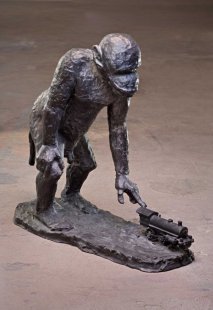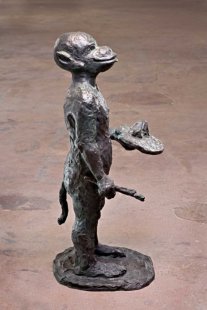
Exhibition Jörg Immendorff - Malerstamm
Quirky, original, unmistakable. This is how the work of painter and sculptor Jörg Immendorff, a leading German artist of recent decades, is described. A selection of the best from his sculptural work, characterized by bizarre figures of monkeys, will be presented by the Prague Gallery Jiří Švestka from September 1 to October 14. The local audience will thus have the opportunity to get acquainted with the work of another top German creator after the Joseph Beuys exhibition at the Museum Kampa or the group presentation of German art from the last 40 years at the Gallery of the Capital City of Prague (City Library, “What Would I Be Without You...”).
On October 10 at 6:30 PM, there will be a lecture by art historian Pavel Liška.
Jörg Immendorff (born 1945) is considered a leading figure in German neo-expressionism, alongside George Baselitz and Anselm Kiefer. In his work—especially in painting—it is possible to trace references to surrealism and Dadaism as well as elements of political comic and satire. He does not hide the spirit of the Kunstakademie Düsseldorf, which he attended.
Immendorff himself hesitates to speak of neo-expressionism or of the "new savages" (Neue Wilde). He rejects unnecessary "politicization" of his work. "Back then, we first thought a lot, and then we painted. Philosophy was our daily bread," recalls Immendorff about the 1970s at the Kunstakademie Düsseldorf. With his contemporaries in art, they commented on the reality of a divided Germany, as well as art itself. They explored the role of the artist in society.
Jörg Immendorff catapulted to the forefront of interest from both the general public and experts with a series of sixteen large-format paintings Café Deutschland, created between 1977 and 1982. His vision of the world was close to parable, ironic commentary, and biting comic. The author incisively glossed social and political life around him, often working with symbols such as the swastika, the workers' fist, the eagle from the German national emblem, or the hammer and sickle.
The work of Jörg Immendorff, especially from the 1980s, is a melting pot of lingering frustration from World War II and the search for a new identity for Germany, the Berlin Wall, the Cold War, a rebellious youth in the West, and frustration from one-party rule in the East, the utopia of a socially just society…
Immendorff was never only concerned with capturing the contemporary atmosphere and reality. A versatile artist who gained renown as a scenographer for leading European theaters and festivals, in his works he always abstracted to more universal questions and problems.
One of Immendorff's central themes is art and artists, with all the connections to society. He reached the roots of the essence of art—mimesis (imitation of reality). On this platform, the first sculptures/figures of monkeys in poses resembling the human world emerged. And especially artists: monkeys in bizarre poses with picturesque expressions on their faces often hold paintbrushes or palettes or resemble contemplative artists or man as a creator in general.
The Jiří Švestka Gallery is currently exhibiting two dozen of these figures (as we can confidently speak of figurative art). The sculptures were installed on higher pedestals, bringing them to human height. The compulsion to compare the world of monkeys and humans is therefore even more intense. The sculptures are complemented by several paintings dating from 2005. In a way, this is a hussar feat by Jiří Švestka, as Immendorff has significantly limited his creative activity in recent years.
The reason is a central nervous system illness (ALS, amyotrophic lateral sclerosis - Lou Gehrig's syndrome), which was diagnosed in the author in 1998. As a result, Immendorff became paralyzed in his left arm and relies on a wheelchair. However, his sarcasm and considerable dose of self-irony have not faded away.
This German painter, scenographer, and sculptor, whose works sell for hundreds of thousands of euros and several of which are also owned by former federal chancellor Gerhard Schröder, now poses the question to himself and the public at the Prague exhibition Malerstamm at the Jiří Švestka Gallery: What is the artist's responsibility for the state of society? What is the purpose of painting and why sculpt? How close is art to questions of ethics and morality? What is art? And what is an artist...?
On October 10 at 6:30 PM, there will be a lecture by art historian Pavel Liška.
Jörg Immendorff (born 1945) is considered a leading figure in German neo-expressionism, alongside George Baselitz and Anselm Kiefer. In his work—especially in painting—it is possible to trace references to surrealism and Dadaism as well as elements of political comic and satire. He does not hide the spirit of the Kunstakademie Düsseldorf, which he attended.
Immendorff himself hesitates to speak of neo-expressionism or of the "new savages" (Neue Wilde). He rejects unnecessary "politicization" of his work. "Back then, we first thought a lot, and then we painted. Philosophy was our daily bread," recalls Immendorff about the 1970s at the Kunstakademie Düsseldorf. With his contemporaries in art, they commented on the reality of a divided Germany, as well as art itself. They explored the role of the artist in society.
Jörg Immendorff catapulted to the forefront of interest from both the general public and experts with a series of sixteen large-format paintings Café Deutschland, created between 1977 and 1982. His vision of the world was close to parable, ironic commentary, and biting comic. The author incisively glossed social and political life around him, often working with symbols such as the swastika, the workers' fist, the eagle from the German national emblem, or the hammer and sickle.
The work of Jörg Immendorff, especially from the 1980s, is a melting pot of lingering frustration from World War II and the search for a new identity for Germany, the Berlin Wall, the Cold War, a rebellious youth in the West, and frustration from one-party rule in the East, the utopia of a socially just society…
Immendorff was never only concerned with capturing the contemporary atmosphere and reality. A versatile artist who gained renown as a scenographer for leading European theaters and festivals, in his works he always abstracted to more universal questions and problems.
One of Immendorff's central themes is art and artists, with all the connections to society. He reached the roots of the essence of art—mimesis (imitation of reality). On this platform, the first sculptures/figures of monkeys in poses resembling the human world emerged. And especially artists: monkeys in bizarre poses with picturesque expressions on their faces often hold paintbrushes or palettes or resemble contemplative artists or man as a creator in general.
The Jiří Švestka Gallery is currently exhibiting two dozen of these figures (as we can confidently speak of figurative art). The sculptures were installed on higher pedestals, bringing them to human height. The compulsion to compare the world of monkeys and humans is therefore even more intense. The sculptures are complemented by several paintings dating from 2005. In a way, this is a hussar feat by Jiří Švestka, as Immendorff has significantly limited his creative activity in recent years.
The reason is a central nervous system illness (ALS, amyotrophic lateral sclerosis - Lou Gehrig's syndrome), which was diagnosed in the author in 1998. As a result, Immendorff became paralyzed in his left arm and relies on a wheelchair. However, his sarcasm and considerable dose of self-irony have not faded away.
This German painter, scenographer, and sculptor, whose works sell for hundreds of thousands of euros and several of which are also owned by former federal chancellor Gerhard Schröder, now poses the question to himself and the public at the Prague exhibition Malerstamm at the Jiří Švestka Gallery: What is the artist's responsibility for the state of society? What is the purpose of painting and why sculpt? How close is art to questions of ethics and morality? What is art? And what is an artist...?
The English translation is powered by AI tool. Switch to Czech to view the original text source.



0 comments
add comment











